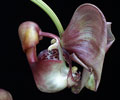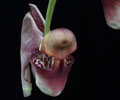|
|
|
|
|
| |
Flasks of
Coryanthes maculata 'Lacey Jean' × self |
|
| |
|
|
| |
| Number: |
TN5043 |
| Name: |
Coryanthes maculata 'Lacey Jean' × self
(Acquired as "Coryanthes sp.")
|
| Type: |
self (What's that?) |
|
Seed Donor: |
Troy C. Meyers
|
|
Click to Enlarge

Pod Parent Flower |
Click to Enlarge

Pod Parent Flower, dorsal view |
Click to Enlarge

Pod Parent Dissected Labellum |
|
|
|
| |
Culture Notes from Donor: Parent plant: Temperature range I (60-83°F)
Comments: Parent plant: One of the offspring of our TN3132 effort in 2002. The parent was an unidentified species in Section Coryanthes from Puerto Ayacucho. In 2006 Dr. Günter Gerlach identified this plant as Coryanthes maculata. It has a "tasty" fragrance of sausages drenched in maple syrup. The flowers are 5 cm from top of cap to bottom of bucket.
For additional origin/habitat information supplied courtesy of
Charles and Margaret Baker, see further below, near the bottom of this page.
|
Temperatures we attempt to use in the lab & greenhouse:
| For Species: |
|
Spring, Summer, Autumn, Winter: days average 88°F, nights 75°F; best fit is Warm 90-70°F
(Source:
Baker's Web OSC) |
|
About the name...
| Etymology of |
Coryanthes |
|
From Greek "korys" helmet; "anthos" flower.
(Source:
Pridgeon 1992) |
| Etymology of |
maculata |
|
From Latin "maculatus" spotted.
(Source:
Mayr & Schmucker 1998) |
| Pronunciation of |
Coryanthes |
|
ko-ree-AN-theez
(Source:
Pridgeon 1992) |
| Pronunciation of |
maculata |
|
mak-yoo-LAH-ta
(Source:
Hawkes 1978) |
|
If you would like to direct someone to this web page, please copy and paste this URL into your email:
http://troymeyers.com/d?015043
| Flask Information |
| Availability: |
We have sold all of the flasks for this item. |
| You should: |
Consider getting individual plants or compots instead of a flask.
You can place a "Notify Flask Recipients" Request, and either we or a flask recipient may contact you when plants are available.
You may also place a "Notify Retries" Request, and if an identical pollination (the same parents) is done again, we'll let you know.
You may reserve a flask, but it's very unlikely you'll get one ...this could only happen if we found a flask that we didn't know we had. |
| Yield Estimate: |
390 plants (based on flask surveys done 08/24/2005 through 12/20/2005)
|
| Plantlet Sizes: |
From many flasks 5 - 100 mm plants (based on flask surveys done 10/27/2005 through 04/04/2006)
From one most recently surveyed flask 80 - 100 mm (04/04/2006)
|
|
You might also want to:
|
View the seed assay for this item.
View items of the same species.
View items of the same genus.
|
| Ordering Information |
| You are not currently logged in. |
|
You must be a registered user and be logged in to reserve a flask or place a notification request. Please log in:
|
|
|
|
|
|
| |
The origin/habitat information below is supplied courtesy of Charles and Margaret Baker
The following information is based on the name of the plant provided by the donor, and assumes that the name is correct. If the plant has been misidentified, then the following information may not be correct.
This text is copyrighted by the Bakers and may not be reproduced without permission.
ORIGIN/HABITAT: Panama, Venezuela, the Guianas (Guayanas), and Brazil.
In Panama, plants are found near Gatún and in the hills east of Panama
City at near sea level. Plants in this region frequently are found in
the tops of slender trees in ant's nests, often in association with
Epidendrum imatophyllum. Williams and Allen ([1946-1949 1980) reported
that these plants "seldom thrive in cultivation, possibly from lack of
some essential element contributed by the ants in their natural
association."
More about this information and the Bakers...
|
|
|
| |
|
|
|